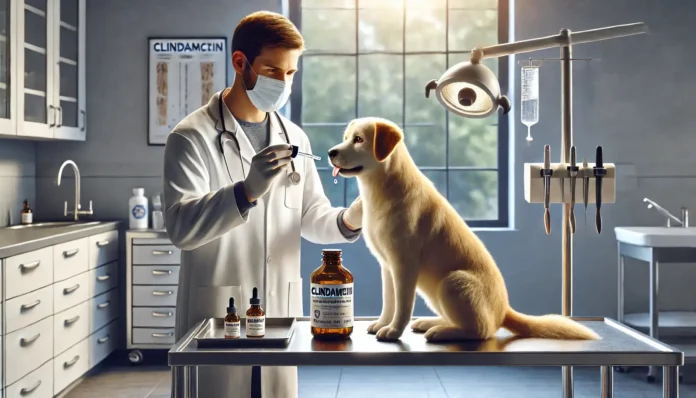Clindamycin dosage for dental dogs is a topic of importance when considering the treatment of dental infections in dogs. Veterinarians often prescribe this potent antibiotic for bacterial infections such as gum disease and abscesses. Clindamycin accelerates healing and restores your dog’s oral health by preventing the growth of bacteria and reducing inflammation.
Your vet decides the right dosage, depending on your dog’s weight and how severe the infection is. For example, tiny dogs may be prescribed 25 mg at a time, while the bigger breeds could get 250 mg. Clindamycin is available in multiple formulations — tablets, capsules, liquid suspensions, and injectables — so it’s adaptable to the needs of your dog.
But treatment comes with its hurdles. Mild side effects such as diarrhea or appetite loss are common, but severe reactions such as difficulty breathing or bloody stools should prompt an immediate call to your veterinarian. Tracking your dog’s development and following the recommended timetable is vital to a successful recovery.
Health risks at the park? Learn how to manage the Derry Dog Park Health Issue and protect your dog.
In addition to antibiotics, preventative care is essential for oral health. Brushing teeth regularly, providing dental chews, and scheduling professional cleanings are all things that can help reduce the risk of future infections. With the right treatment in place, combined with preventative care, you can maintain a healthy smile and a wagging tail!
This guide will cover everything you need to know about clindamycin for dogs, including dosage instructions, side effect management, and prevention of dental problems. So let’s get right to it so your four-legged friend can live a painless, happy life!
Proper dental care starts with understanding the basics. Read our dental health guidelines for dogs for tips on keeping your pet’s teeth clean.
Understanding Clindamycin for Dogs
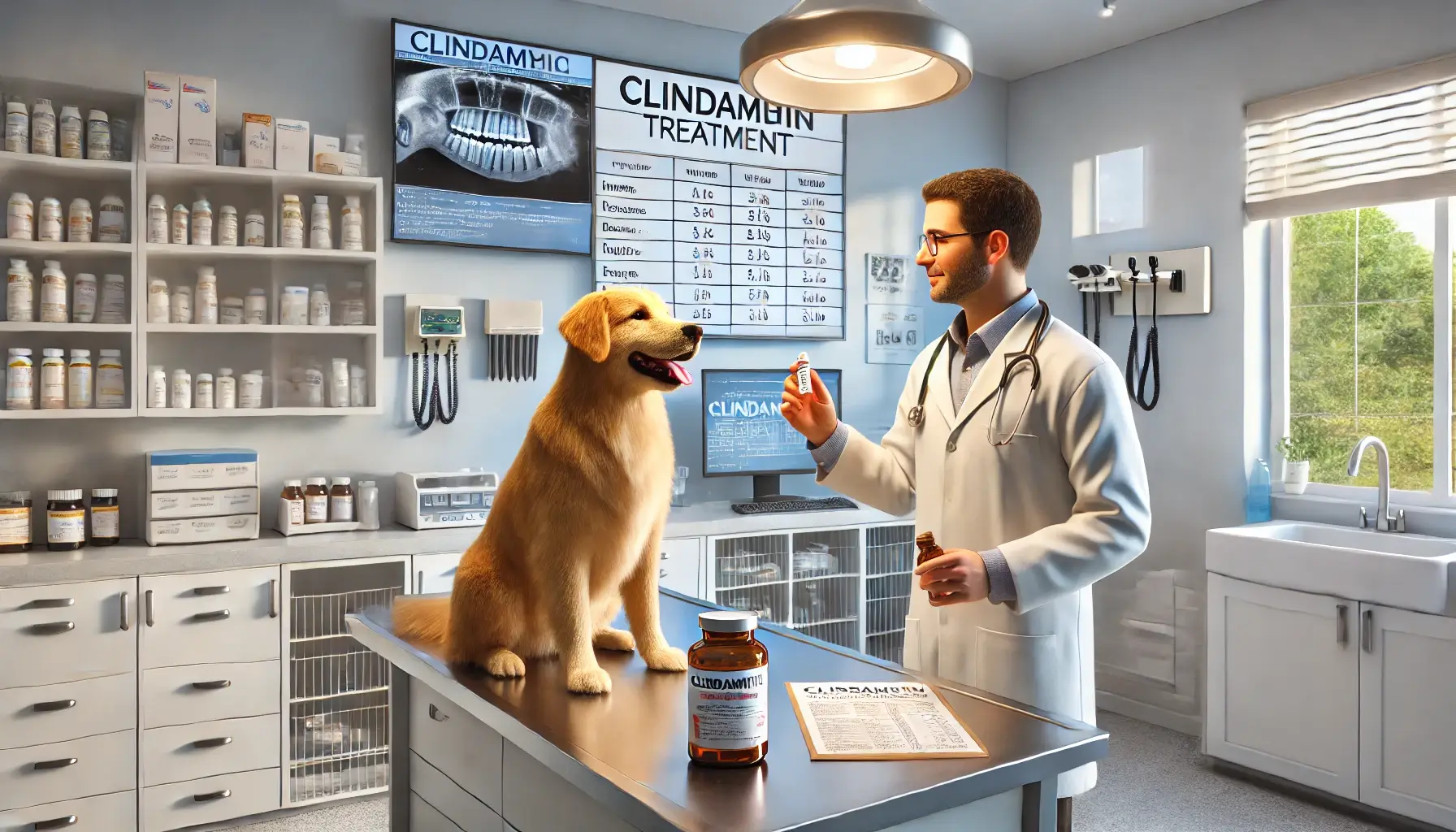
What Is Clindamycin?
The antibiotic clindamycin helps treat bacteria found infected in dogs. It is a member of a class of antibiotics called lincosamides. This class of medication works by preventing the bacteria from growing and spreading. It helps your dog’s immune system take the upper hand in fighting the infection.
Veterinary prescriptions for clindamycin usually go to infections caused by particular bacteria. This can be from a skin infection, a soft tissue infection, or, dental problems. It is typically provided in tablet, capsule, or liquid form. You may even hear veterinarians refer to brand names such as Antirobe or Clintabs.
Clindamycin is not effective against viral infections, so it’s important to let your vet decide if it’s the right drug for your dog. You should keep in mind that you should always follow the expert’s advice when providing your dog antibiotics.
Curious about what to expect after a dental cleaning? Explore the before and after guide to dog dental cleaning.
Why Is Clindamycin Prescribed for Dental Issues?
Just like humans, they can experience a variety of dental problems. Abscesses or gum infections caused by bacteria or even dental disease are common problems. These conditions may be painful for your dog and could cause further health complications without treatment.
Clindamycin is effective because it specifically targets the bacteria causing these infections. It helps to reduce inflammation, control the infection, and achieve quick healing. This antibiotic penetrates deep into the tissue to attack the infection at its source, for dental abscesses.
They prescribe clindamycin to restore your dog’s oral health and prevent complications, including the loss of teeth or dissemination of the infection. Remember, a healthy mouth often means a happier, healthier dog overall.
Dental disease can lead to serious health issues. Learn how professional cleaning can make a difference with our teeth cleaning before-and-after guide.
Appropriate Clindamycin Dosage for Dogs
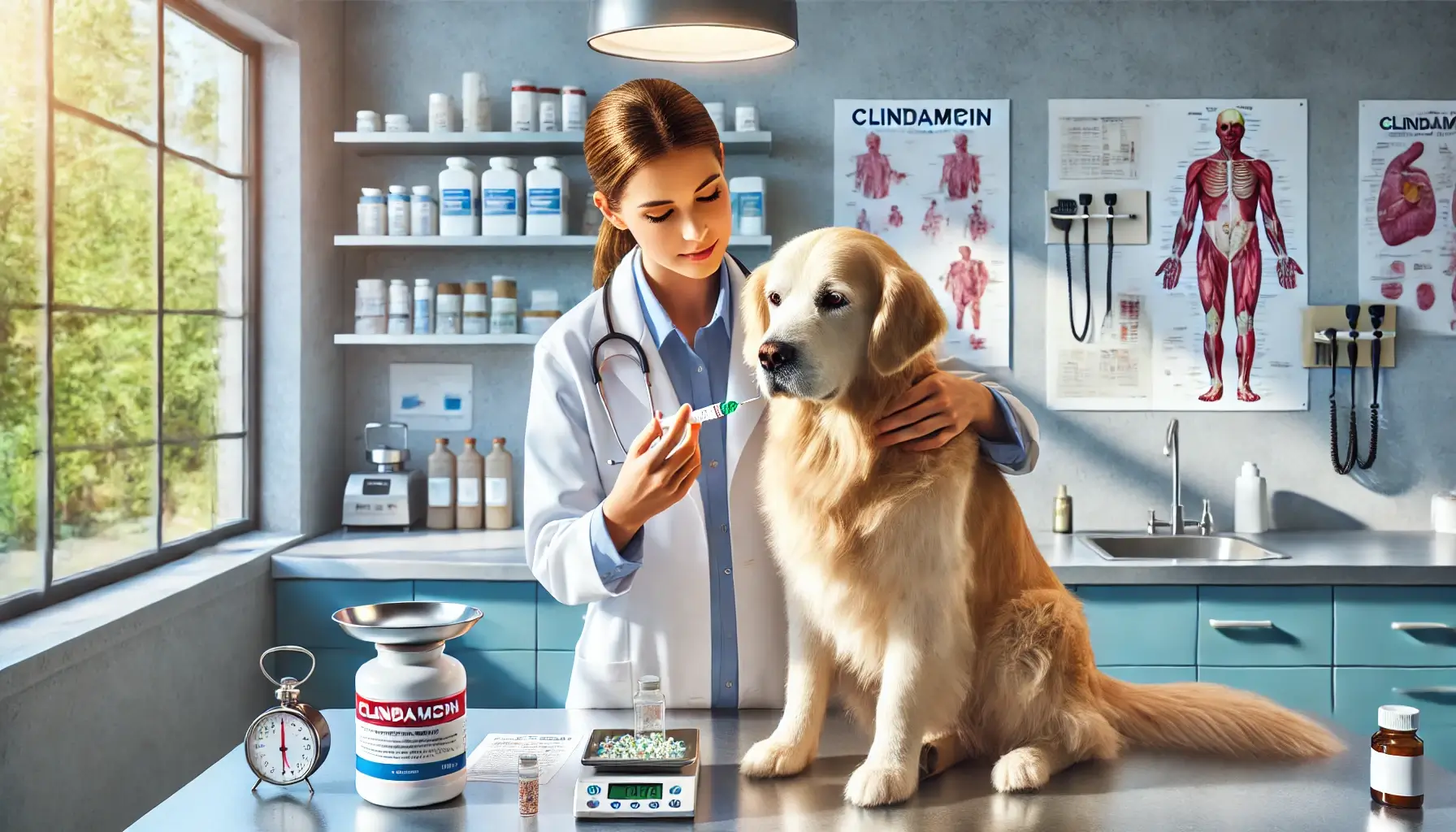
General Dosage Guidelines
The dosage for clindamycin in dogs is primarily based on weight. Vets typically prescribe milligrams per kilogram (mg/kg) of your dog’s weight. The standard dose for most dental infections is approximately 5.5 mg to 11 mg per kilogram every 12 hours.
Here’s a quick example to help:
- 10 lbs (4.5 kg): 25-50 mg per dose
- 20 lbs (9 kg): 50-100 mg per dose
- 50 lbs (22.7 kg): 125-250 mg per dose
Your vet will calculate the exact dose for your dog. Never guess or give human antibiotics without professional advice, as this can be harmful.
Factors Influencing Dosage
Every dog is unique, so the correct dosage isn’t only a matter of weight. The severity of the infection matters a lot. A lower dose may suffice for mild gum inflammation, while severe abscesses may require a higher one.
Your dog’s age and breed also make a difference. Young puppies and senior dogs may need more cautious dosing because of developing or aging systems. And some of the breeds may metabolize medication differently.”
Medication interactions are another primary driver. If your pup is on other meds, like anti-inflammatory drugs or supplements, your vet will adjust the dose accordingly to prevent side effects or reduced effectiveness.
You should never deviate from your veterinarian’s directions. Too much, too fast, can trigger side effects; too little may fail to clear the infection. You can trust your vet to strike the right balance for your pup.
How to Administer Clindamycin to Your Dog
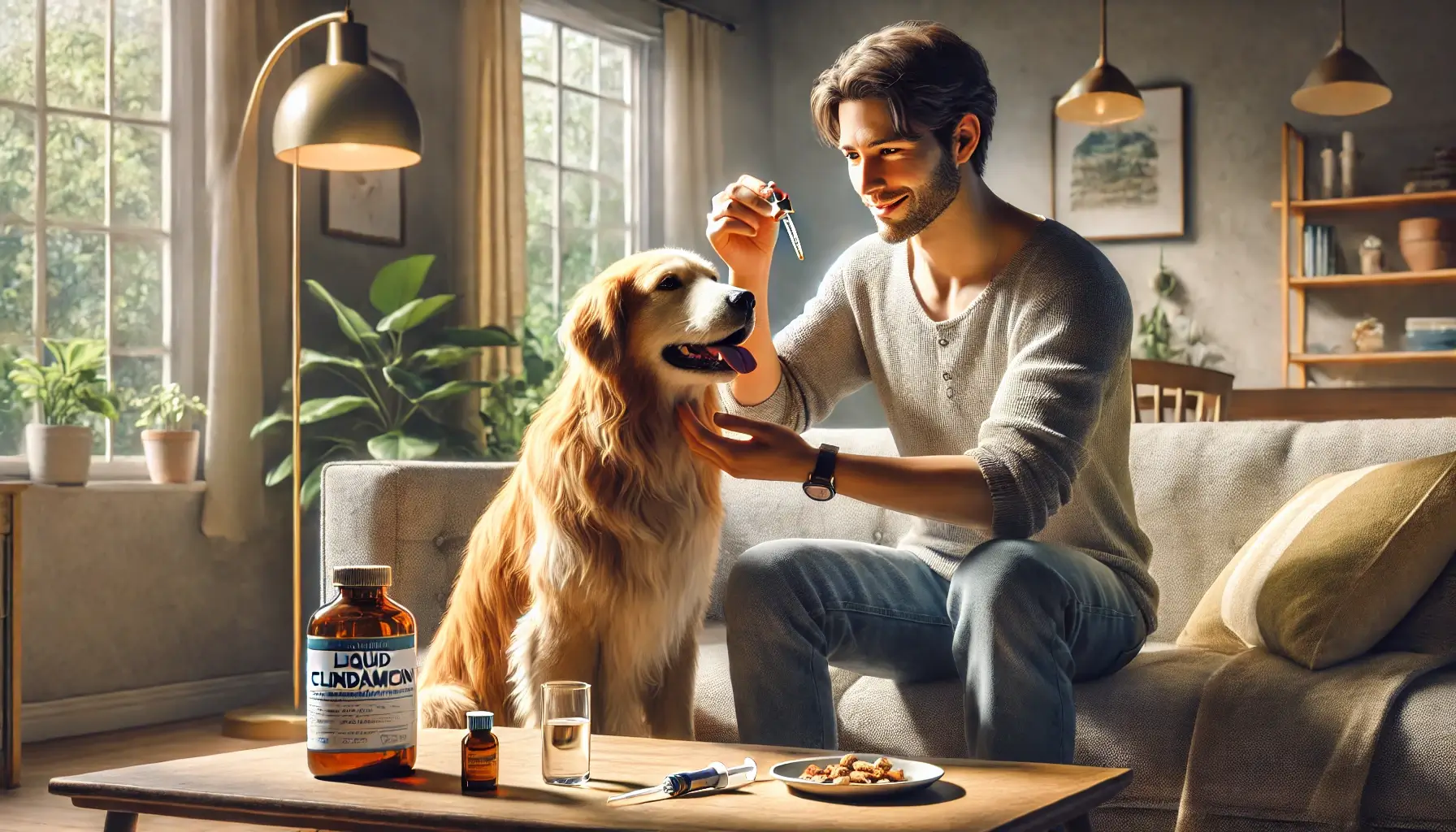
Forms of Clindamycin Available
Clindamycin is available in different forms to better suit your dog’s needs. The most prevalent types are:
- Tablets or capsules: Easy to gauge doses, but giving to choosy eaters may take some ingenuity.
- Liquid Suspensions: Ideal for smaller dogs or those that have difficulty swallowing pills.
- Injectables: Administered by a vet, these are for severe cases or when oral meds aren’t possible.
Your vet will advise on the most appropriate type for your dog similarly to the other types about the size and severity of the infection and ease of administration.
What should you feed your dog after a dental procedure? Get the answers in our post-dental cleaning feeding guide.
Step-by-Step Guide to Giving Clindamycin
Giving your dog medicine can feel tricky, but these tips can help:
- For Pills or Capsules:
- Hide the pill in a pill pocket or soft treat, such as peanut butter or cheese.
- If the above options are too challenging, use a pill pocket.
- If necessary, gently open your dog’s mouth, position the pill on the back of their tongue, and close their mouth. Rub their throat so they will swallow.
- For Liquid Medicine:
- Administer with the supplied syringe or dropper.
- Gently raise your dog’s muzzle and slide the dropper into the side of their mouth.
- Gently squeeze the liquid, allowing your dog to swallow naturally.
Tips for Stress-Free Administration:
- Give a treat before and after so you make it a positive experience.
- Be sure to remain calm and patient, as your dog will pick up on any frustration.
- If your dog refuses, consult your vet for extra tips or methods.
Successful treatment requires consistency and care, so adhere to your vet’s schedule.
Can vaccinations be done during dental cleaning? Find out in our detailed guide here.
Potential Side Effects of Clindamycin in Dogs
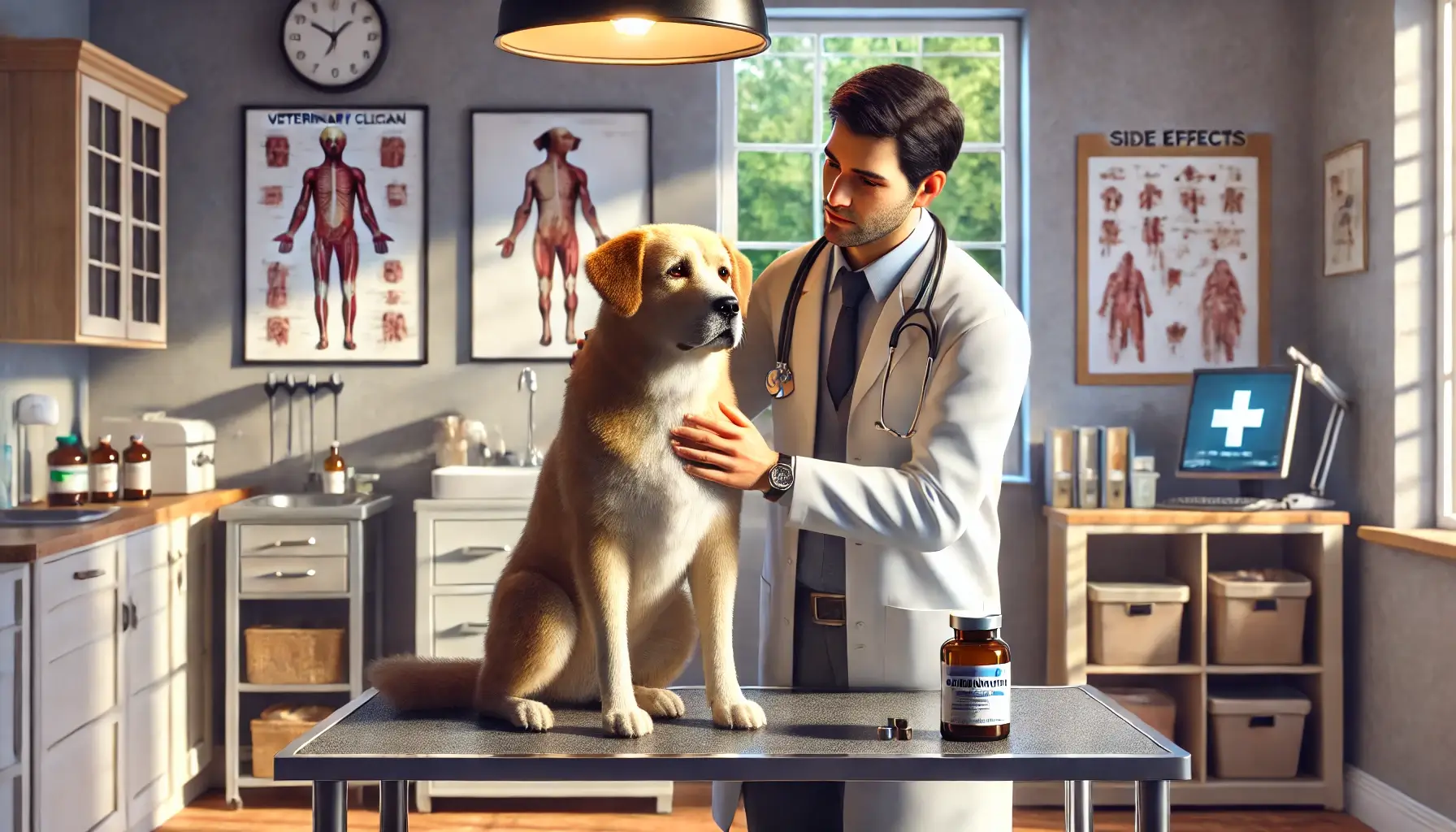
Common Side Effects
As with any medication, clindamycin may cause certain side effects in dogs. Here are some of the most common:
- Diarrhea: Loose stools are a common response as your dog’s body gets used to the medication.
- Nausea: Some dogs will vomit, particularly if the drug has been given on an empty stomach.
- Loss of Appetite: Your dog may refuse food while on an antibiotic.
These side effects are usually mild and resolve once treatment ends. If they persist, let your vet know.
Serious Side Effects to Watch For
Serious adverse effects can occur, though they are rare and can be immediately treated. Look out for:
- An Allergic Reaction: If you notice swelling, hives, or just seem to be itching a lot.
- Difficulty Breathing: This may be a sign of a serious allergic reaction.
- Severe Gastrointestinal Issues: Bloody diarrhea or repeated vomiting may indicate a serious problem.
If your dog experiences any of these symptoms, discontinue the medication and call your vet immediately. They can adjust the dose, or prescribe another antibiotic.
Managing Side Effects
For mild problems, such as diarrhea or an appetite that is not quite what it used to be, you can try the following remedies:
- Home remedies: Mix a little plain, boiled chicken or rice into your dog’s food. It can calm down their stomach.
- Fluoxetine Dosage: Never modify dosage by yourself. If you suspect the current dose is too powerful, consult your vet.
- Alternatives for antibiotics: If the side effects are too bad or last too long, your vet may select a different medication.
You respond to your dog closely through treatment to ensure their safety and well-being. For the best results, always follow the advice of your vet.
How often should dogs get their teeth cleaned? Discover the recommended schedule in our complete guide.
Clindamycin Dosage for Dental Infections: Case Studies and Examples
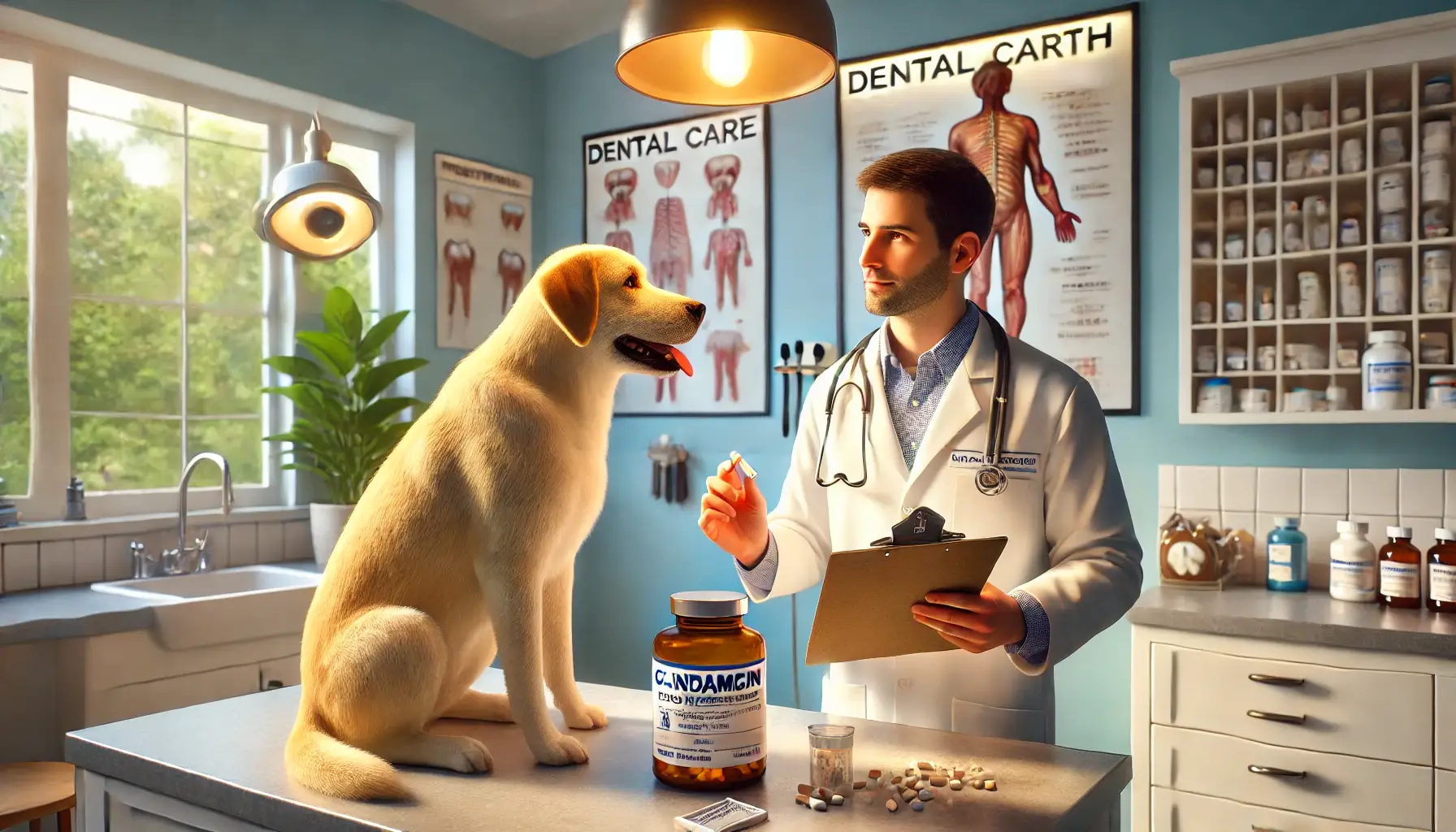
Real-Life Cases
Example 1: How to Treat a Tooth Infection
Meet Bella, a 25-pound mix of Labrador, with red, swollen gums. Her veterinarian found her to have mild gingivitis. Bella was started on clindamycin 5.5 mg/kg twice daily for seven days. The vet suggested Omeprazole in a liquid suspension for easier administering.
By day three, Bella was improving. Her gums were less angry, and her appetite came back. Her oral health returned to form after completing the course with no side effects.
Example 2: Treating a Serious Tooth Abscess
Rocky, a 60-pound German Shepherd, had a painful molar abscess. His vet recommended clindamycin at a higher dose of 11 mg/kg bid for 14 days. The abscess was drained to relieve pressure, along with antibiotics.
In a week, the swelling in Rocky’s neck began to dissipate. At the end of treatment, the infection was completely cleared and he was back to enjoying his meals.
Lessons Learned
Proper Dosage Equals Better Recovery
These cases both emphasize the importance of individual dosages. Bella had a mild infection and needed a standard dose, while Rocky had a severe abscess and required a more powerful regimen. The vet’s recommendations provided an effective and safe treatment.
Mistakes to Avoid
- Skipping Doses: If you miss a dose, it can make the antibiotic less effective. Stick to the schedule.
- Quitting Early: Even if you feel better, take the full course to avoid a relapse.
- Wrong Administration: Ensure correct medication and dosage are given to avoid unnecessary complications
Understanding the consequences of clindamycin therapy from these examples can teach you the importance of good care. Always check with your vet for personalized advice.
Alternatives to Clindamycin for Dogs’ Dental Issues
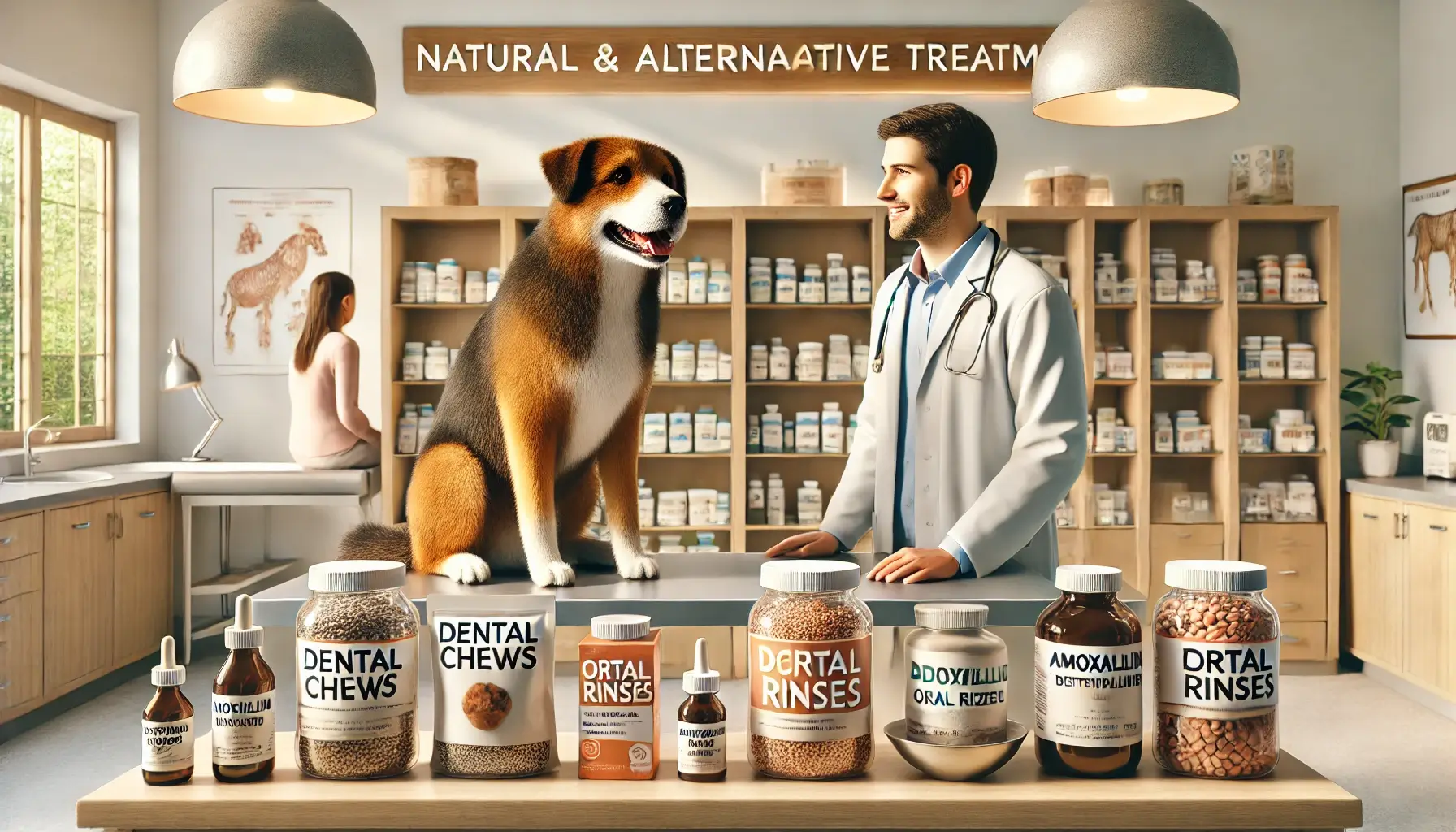
Other Antibiotics for Dental Infections
If clindamycin isn’t suitable for your dog, there are other antibiotics that your vet may recommend:
- Metronidazole: Generally used for anaerobic bacteria, frequently combined with another antibiotic.
- Amoxicillin: Commonly used to treat dental infections because of its broad-spectrum antibiotic activity.
- Doxycycline: Helps with certain strains of bacteria, and may be a reasonable alternative if clindamycin leads to side effects.
Each of these antibiotics has its benefits and its risks. Before prescribing an alternative, your vet will take into account things like the severity of the infection, your dog’s health history, and possible side effects.
Natural Remedies and Preventative Measures
While antibiotics treat existing infections, prevention is key to long-term dental health. Here are some natural remedies and tips to maintain your dog’s oral hygiene:
- Dental Chews: You can reduce plaque and tartar buildup by giving your dog special chews that help keep teeth clean and healthy.
- Oral rinses: Dog-safe antibacterial rinses fight bacteria and freshen your breath.
- Teeth Brushing: Brush their teeth two to three times a week when you use dog-friendly toothpaste and brush. This helps to prevent bacteria build-up and prevents infections.
- Professional Cleanings: Have regular dental cleanings performed by your veterinarian. They can catch problems earlier, and prevent more serious conditions.
If you combine good hygiene practices with timely veterinary care you can greatly reduce the risk of dental issues in your furry friend. Always consult your vet before trying new remedies or changing medications.
Frequently Asked Questions About Clindamycin for Dogs
Can I Give My Dog Clindamycin Without a Prescription?
No, you should never give clindamycin to your dog without a prescription. This antibiotic is designed to address specific bacterial infections, and a veterinarian must approve that it’s right for your dog’s situation. Misuse can result in ineffective treatment or dangerous side effects. Always reach out to your vet before administering any medication to your dog.
How Long Does Clindamycin Take to Work?
Clindamycin typically works in about 1-2 days of the first dose. You may see a decrease in symptoms, such as swelling and appetite in this period. But a complete course of treatment, typically lasting between 7-14 days, is required to fully get rid of the infection. Even if your dog appears better, keep up the medication as directed to avoid a relapse.
Is Clindamycin Safe for Puppies?
Clindamycin is safe for puppies. However, some factors influence its safety: the puppy’s age, weight, and general health. Puppies are very sensitive to medications, so the vet will do a careful calculation of the dosage to make sure it’s safe.
In case your puppy is put on clindamycin, pay extra close attention to them for any side effects like diarrhea or vomiting. As always with your puppy’s health and safety, follow your vet’s instructions to ensure a proper and safe recovery.
Expert Tips for Ensuring Effective Treatment
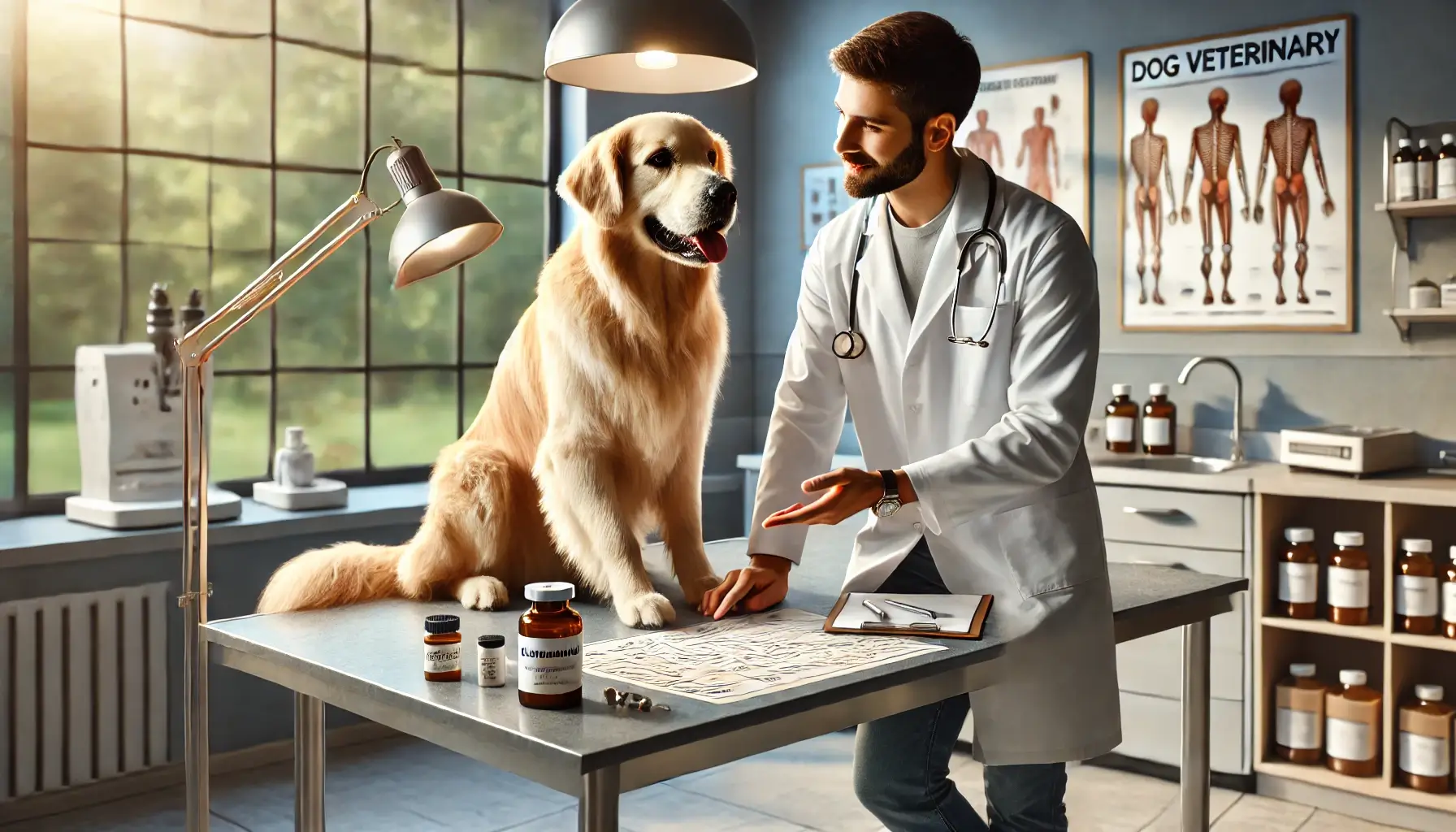
Monitoring Your Dog’s Progress
Monitoring your dog’s recovery is very important while taking clindamycin. Signs your infection is healing Look for these signs to know the infection is getting better:
- Less Swelling: Any swelling surrounding the gums or teeth should subside.
- Return of Appetite: Your dog should start eating normally again.
- Increased Energy: It’s a positive sign if they return to their normal playful behavior.
If you don’t see any improvement after a few days, or if symptoms worsen, call your vet. They should adjust the dosage or undergo another treatment. Make a follow-up appointment with your vet when the course is complete to help make sure the infection is gone.
Avoiding the Recurrence of Dental Infections
Just as important as treating issues is preventing them. To keep your dog’s teeth and gums healthy, here are a few tips:
- Regular Teeth Brushing: You should brush your dog’s teeth 2–3 times per week with dog-friendly toothpaste. This aids in avoiding plaque buildup.
- Provide Dental Chews: These chews can help curb tartar and keep teeth cleaner between brushings.
- Balanced Diet: Give your dog the kind of diet that helps improve overall health — including that of their teeth and gums.
- Routine Vet Check-Ups: Regular dental examinations and cleanings are incredibly important. Your vet can detect problems early and deal with them before they get serious.
With this sequential list, and conversion to being proactive, you can maintain your dog’s teeth, and avoid the antibiotic modality going forward. Well, you know the rest — happy jaw, happy dog!
Conclusion: The Importance of Proper Dosage and Veterinary Guidance
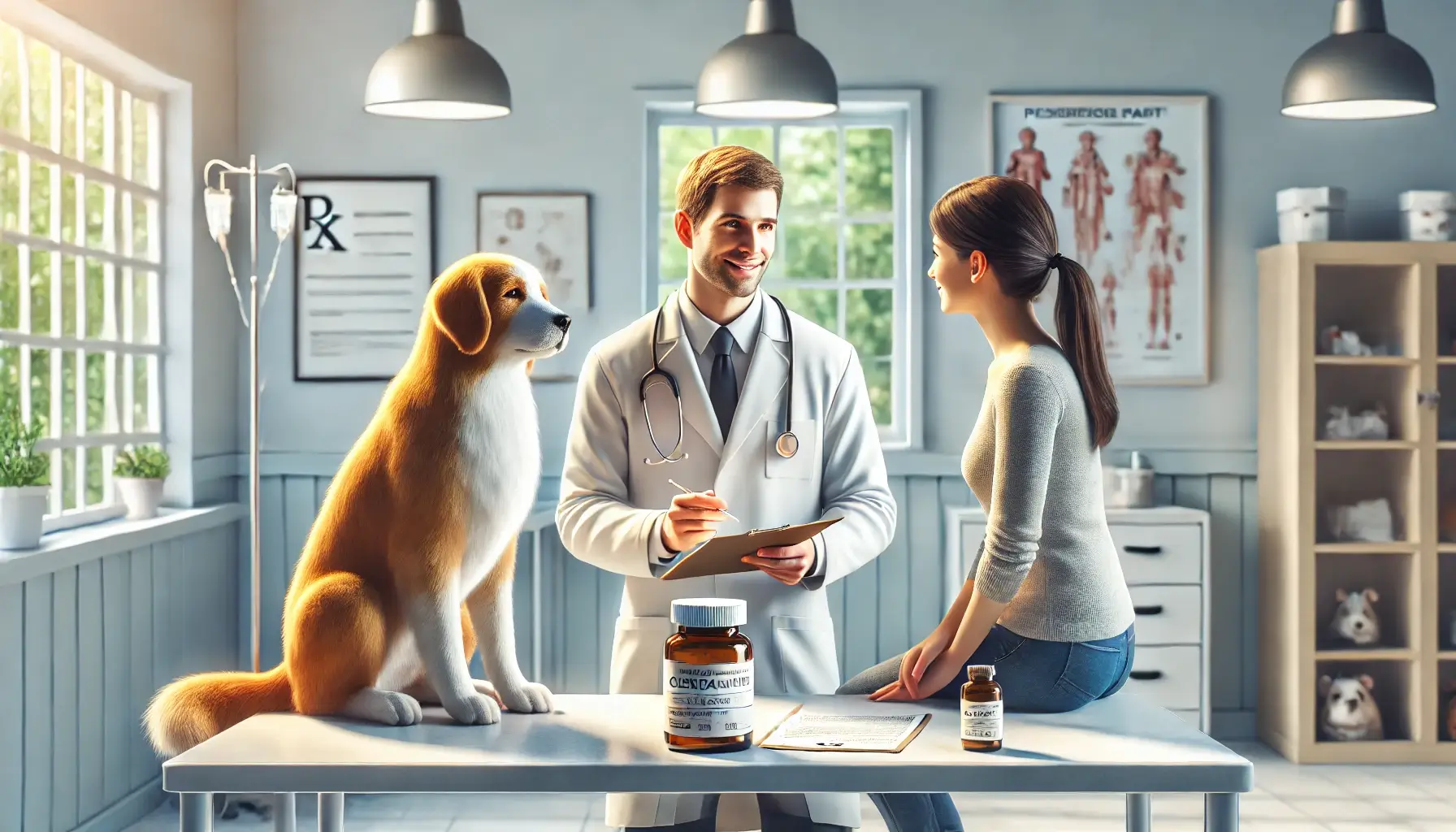
A good mendicant, along with good hygiene, can help keep your dog’s teeth healthy. Clindamycin is a strong antibiotic used to treat bacterial infections, such as gum disease and abscesses. However, its effectiveness relies on the right dosage and treatment plan based on your pup’s specific needs.
In this guide, we’ve covered how clindamycin works, what dosage is appropriate, potential side effects, and tips for taking it. We’ve also underscored the need for monitoring your dog’s progress while in treatment, and how to handle side effects as they will inevitably arise. Brushing daily, using a dental chew, and having regular cleanings can go a long way in preventing dental problems from recurring.
Veterinarians play an invaluable role in that process. Your vet doesn’t simply prescribe clindamycin; they evaluate your dog’s health issues, determine the appropriate treatment plan, and guarantee that the drug is safe and effective. Make sure to check with your vet before applying any antibiotic treatment to prevent any possibilities of posing risks and get the best results for your furry companion.
With proper veterinary care and good oral hygiene practices, you can maintain your dog’s dental health and overall well-being! Remember, a happy dog is a healthy dog, and proper dental hygiene is an important aspect of that equation. Follow your vet’s directions, stay the course with your dog’s treatment, and set the stage for a healthier, happier life for your four-legged best friend.
Popular Article
Dental Health in Dogs Guidelines
Dog dental cleaning before and after
Dental disease dog teeth cleaning before and after
How long do dog dental cleanings take
What to Feed Dog After Dental Cleaning
Can dog annual vaccinations be done during dental cleaning
How often do dogs need dental cleaning
Can dogs get dental implants
Dog Heat Cycle Calculator
chinook dog health issues


